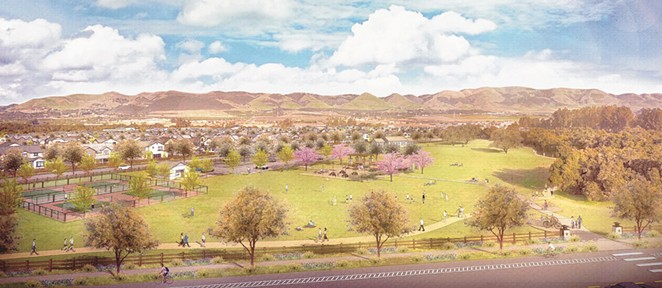Titan Drama Hall of Fame photos presided over the more than 300 people seated in metal folding chairs at Nipomo High School’s cafeteria/performing arts center on July 24.
Green Nipomo Action Committee shirts competed for attention with heather blue Home For All tees as South County Advisory Council chair Kevin Beauchamp attempted to call attention to the meeting above the din. Almost everyone who attended was there for one reason: the controversial Dana Reserve—a 1,200-plus unit housing development proposed in Nipomo and the largest project planned in a quarter century.
“Let’s keep it civil,” 4th District Supervisor Jimmy Paulding told the crowd. “Be respectful of everybody’s comments.”
The council heard from the developer and area residents that evening but held off on making a decision until its next meeting, after the project’s final draft environmental impact report is released on Aug. 4.
Dana Reserve developer Nick Tompkins touted the project as an answer to the region’s jobs/housing imbalance, infrastructure deficit, and housing affordability issue. After 79 public outreach meetings to gain county and community input, Tompkins said that what became clear to him was that most of the people who live in Nipomo believe that the basic infrastructure is lacking—water, fire, health care, sewer, sheriff, schools, roads.
He said that neither more housing nor better infrastructure could exist “without solving for both.”
However, project opponents point to some of the impacts of the project as reasons to either downsize it or kill it. These include an influx of thousands of new residents that would strain infrastructure and increase traffic, as well as the environmental cost of the project, which includes cutting down more than 3,000 oak trees on a 288-acre parcel near Willow Road.
“Some people would prefer for us to scrap the project entirely and leave the trees,” Tompkins said, to raucous applause. “However, we are in the middle of a housing and affordability crisis. … Current and future generations have a need for both housing and infrastructure.”
The project includes plans for a village shopping center, a California Fresh Market grocery store, a South County Cuesta College campus, neighborhood parks and walking trails, a 55-and-older age-restricted neighborhood, 104 inclusionary housing units donated to People’s Self-Help Housing, completing the N. Frontage Road up to Willow Road, and a promise to preserve and/or plant more than five oak trees for every oak tree removed.
Alison Martinez, a Nipomo Action Committee member and area resident, spoke during public comment, saying that three years into the public’s knowing about the project, they’ve spoken with thousands of local residents who are opposed to the Dana Reserve.
“We’ve collected nearly 4,000 signatures against the project, which is 25 percent of Nipomo’s population,” she said, adding that a better project would find “a balance between housing and protecting the oak trees.”
Others who spoke against the project were concerned about the dust that project construction would create, water issues, traffic, a lack of primary and secondary schools to go along with the development, and the reality of whether the homes would actually be as affordable to the “missing middle” as Tompkins touted.
“Houses for rich people are already overbuilt. If you build more houses like that, people are just going to come in from LA and San Francisco,” one resident said.
However, many of the proponents who spoke said that more housing was needed in an area where the majority of people who grew up there couldn’t afford to purchase a home. One teacher said that both he and his wife have taught in Nipomo area schools for more than five years, but they live in Guadalupe due to housing costs.
“It’s important for educators like ourselves to be able to live in the communities in which we teach,” he said. “The Dana Reserve project offers us a unique and wonderful opportunity to be able to find homes within our budget.”
The project will go back before the South County Advisory Council on Aug. 28 and is scheduled to be heard by the SLO County Planning Commission on Aug. 30 and 31.



